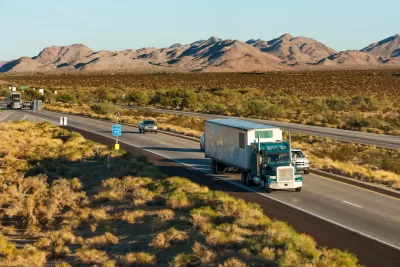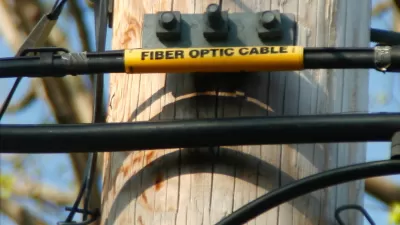The Arizona Department of Transportation announced a public-private partnership to install fiber-optic infrastructure along 405 miles of interstate highways to enable vehicle connectivity.

A new project announced in April will lay the groundwork for connected and automated vehicles in Arizona, according to a Gov Tech article by Skip Descant. “The project, a partnership among the Arizona Department of Transportation (ADOT), the Arizona Commerce Authority and eX2 Technology…will lay 405 miles of fiber along interstates 40, 19 and 17,” Descant reports.
The project, which is expected to begin later this year, will serve dual purposes: a ‘testbed” for intelligent transportation systems technology and “middle-mile” broadband “intended to build out the infrastructure needed to support final ‘last-mile’ connections to homes and businesses,” particularly those in rural areas and on tribal lands. In addition to connected and automated vehicles, an ADOT representative told Gov Tech the new fiber infrastructure will support overhead message boards, traffic cameras, weather stations, and wrong-way driving detection.
“The project is seen as a significant advancement of the national goal to bring broadband to unserved and underserved areas. Arizona received more than $993.1 million from the Broadband Equity Access and Deployment (BEAD) Program, part of the 2021 federal Infrastructure Investment and Jobs Act,” writes Descant.
FULL STORY: Arizona Fiber Work Will Connect Vehicles and Residents

Alabama: Trump Terminates Settlements for Black Communities Harmed By Raw Sewage
Trump deemed the landmark civil rights agreement “illegal DEI and environmental justice policy.”

Study: Maui’s Plan to Convert Vacation Rentals to Long-Term Housing Could Cause Nearly $1 Billion Economic Loss
The plan would reduce visitor accommodation by 25% resulting in 1,900 jobs lost.

Why Should We Subsidize Public Transportation?
Many public transit agencies face financial stress due to rising costs, declining fare revenue, and declining subsidies. Transit advocates must provide a strong business case for increasing public transit funding.

Paris Bike Boom Leads to Steep Drop in Air Pollution
The French city’s air quality has improved dramatically in the past 20 years, coinciding with a growth in cycling.

Why Housing Costs More to Build in California Than in Texas
Hard costs like labor and materials combined with ‘soft’ costs such as permitting make building in the San Francisco Bay Area almost three times as costly as in Texas cities.

San Diego County Sees a Rise in Urban Coyotes
San Diego County experiences a rise in urban coyotes, as sightings become prevalent throughout its urban neighbourhoods and surrounding areas.
Urban Design for Planners 1: Software Tools
This six-course series explores essential urban design concepts using open source software and equips planners with the tools they need to participate fully in the urban design process.
Planning for Universal Design
Learn the tools for implementing Universal Design in planning regulations.
Smith Gee Studio
Alamo Area Metropolitan Planning Organization
City of Santa Clarita
Institute for Housing and Urban Development Studies (IHS)
City of Grandview
Harvard GSD Executive Education
Toledo-Lucas County Plan Commissions
Salt Lake City
NYU Wagner Graduate School of Public Service



























